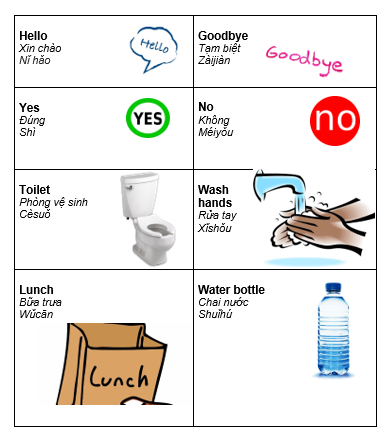21 Vietnamese and Chinese essential phrases
Courtney McEwan

Download the resource: McEwan Intercultural
The resource created provides educators with a range of flashcards to assist children with English as an additional language or dialect (EAL/D). The cards include common objects/phrases used within the early childhood environment and include a picture, the word in English, as well as in Vietnamese and Chinese. Educators can use this resource to assist in settling upset children or to implement routines with children who have EAL/D. The resource is editable which allows educators to add words where necessary. The resource can be displayed on the wall, or the cards can be cut out and laminated for children’s personal use. EAL/D learners can use the resource to make connections between the pictures and words/phrases, assisting with early literacy development and building of vocabulary (Durgunoglu & Goldenberg, 2011). The resource can also be used by educators to celebrate diversity within the service and deepen the children’s understanding of culture as they are exposed to words and phrases in a number of languages (Early Childhood Australia Learning Hub, 2012).
The resource allows educators to communicate basic words and phrases in Vietnamese and Chinese, which supports the first language and provides opportunities to interact with children from diverse linguistic backgrounds, thus building meaningful relationships and supporting language development through quality interactions (Gallagher & Mayer, 2006). When meaningful and supportive learning environments are created, children feel safe and secure in their right to use their own language and enjoy their own culture (United Nations General Assembly, 1989).
Links
Early Years Learning Framework (DEEWR, 2009)
- Outcome 1: Children have a strong sense of identity
- 1.1 Children feel safe, secure, and supported
- 1.3 Children develop knowledgeable and confident self-identities
- 1.4 Children learn to interact in relation to others with care, empathy, and respect
Outcome 2: Children are connected with and contribute to their world
- Children respond to diversity with respect
Outcome 5: Children are effective communicators
- Children interact verbally and non-verbally with others for a range of purposes
- Children engage with a range of texts and gain meaning from these texts
National Quality Standards (ACECQA, 2018)
- Quality Area 5 – Relationships with children
- 5.1: Respectful and equitable relationships are maintained with each child
- 5.1.2: The dignity and rights of every child are maintained
- 5.1: Respectful and equitable relationships are maintained with each child

